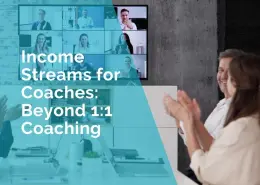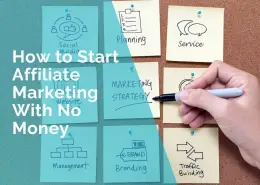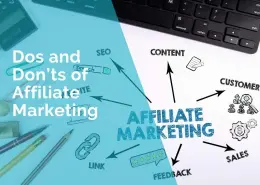8 Ways to Make Money with Your Website
1. Selling Your Own Products & Services
If you want to make money with your website by selling your products online, you need a shopping cart. Forget about having printable order forms or asking people to email you to place an order, because in most cases they won’t.
If you make it too difficult to buy your products, your visitors will go elsewhere. You have several options:
- Get your web developer to create a custom shopping cart for you, although this can be quite costly
- Use existing shopping cart software such as Shopify or if you have a WordPress website, install WooCommerce Plugin
- Set up a free Paypal shopping cart – all you need to do is sign up for Paypal Business or Merchant account.
2. Selling Your Products via Amazon Store or eBay
You can create your own website using WordPress and include all your information about your business, frequently asked questions, etc, but then link your website to an Amazon or eBay store.
The reason I suggest this is because all the technical aspects are taken care of by Amazon or eBay. Both companies make it super simple to set up – they tell you where to upload images, where to add product descriptions, pricing, shipping etc
This is a great solution for a lot of small businesses who are testing out their products, as they don’t have to invest a lot of money into a full ecommerce website initially. The other advantage is that Amazon and eBay will drive traffic to your store.
Although you can just have an eBay or Amazon store, I recommend creating your own website with your own domain name as you have control over that.
Keep in mind if people complain about your products, Amazon or eBay can temporarily or permanently cancel your account. It can take a long time to reinstate so your business could be down for a while. Whereas if you have your own website, you simply need to only rebuild the shopping cart component.
You may even consider setting up an affiliate/partner program, which will allow others to sell your products.
The great thing about this is that you only have to pay them when they sell your products. There are some excellent websites, which allow you to easily set up an affiliate program. For more information visit the following (or simply search on “affiliate programs”
3. Selling other people’s products via Affiliate Programs
Another way to make money with your website is via affiliate programs. An affiliate (also known as associate, partner or referral) program is simply any type of revenue sharing program where a website owner receives a portion of income for generating leads, traffic, or sales through a graphic or text link to a merchant website.
Merchants specify how much affiliates will be paid and under what payment terms, how sales will be tracked and when/how payments will be made. The great thing is that it doesn’t cost you anything to join and you earn commission simply by referring people to the merchant’s website.
You don’t need to ship any products or handle any payments. Again, all you do is place special code on your website and the rest is done automatically. There are hundreds of different affiliate programs, so you can find products that complement your products/services.
Learn more about Affiliate marketing
4. Direct Advertising
If you have an established website with a decent amount of traffic you could approach businesses who have similar target audiences as you and offer them space on your website to place banners or ads.
This can be time consuming and if your business is currently not getting much traffic it may be difficult to find advertising partners.
5. Ads via Advertising Platforms
Integrating advertising into your website can indeed be made easier with the help of advertising platforms such as Ezoic, Mediavine, Adthrive, and Google AdSense.
These platforms offer a straightforward and efficient way to make money with your website while allowing you to focus on creating engaging material for your audience.
Here’s how these platforms work:
- Platform Selection: As a website owner or publisher, you can choose from various advertising platforms based on your preferences and requirements. Each platform may have its eligibility criteria, payment models, and specific features.
- Seamless Integration: Once you’ve selected a platform, you’ll typically need to sign up and follow their setup instructions. These platforms provide you with the necessary code snippets or plugins to seamlessly integrate ads into your website. The integration process is often user-friendly and doesn’t require extensive technical knowledge.
- Ad Placement: After integration, the advertising platform will automatically analyze your website’s content and user behavior. It uses this information to place relevant ads strategically on your webpages. These ads may come in different formats, including display ads, text ads, or even video ads.
- Targeted Advertising: One of the key advantages of these platforms is their ability to target ads based on the content of your website and the interests of your audience. This targeted advertising helps increase the chances of user engagement, such as clicks or conversions, which, in turn, boosts your revenue potential.
- User Experience: Reputable advertising platforms prioritize the user experience. They aim to strike a balance between displaying ads and maintaining a pleasant browsing experience for your visitors. You can often customize ad placements to ensure they complement your site’s design and content seamlessly.
- Earnings and Payment: With these platforms, you earn revenue based on various payment models. Google AdSense, for example, offers Cost Per Click (CPC), where you earn money when users click on ads. Others, like Ezoic and Mediavine, often work on a Cost Per Mille (CPM) model, paying you based on ad impressions (views). Earnings accumulate over time, and you typically receive payments monthly or according to the platform’s payment schedule.
- Analytics and Reporting: Advertising platforms usually provide comprehensive analytics and reporting tools. You can track your ad performance, view earnings, and gain insights into your audience’s interaction with the ads. These insights can help you refine your content and ad strategies.
- Policy Compliance: It’s essential to adhere to the policies and guidelines set by the advertising platform. Non-compliance can lead to issues with your account and potentially impact your revenue. Adhering to best practices ensures a positive experience for both you and your visitors.
6. Online Consulting / Coaching / Training
This is particularly suitable for service providers such as coaches and consultants, who can provide training/consulting via Zoom or Skype. Training can be provided one on one or one to many.
You can easily integrate booking calendars such as Calendly or Bookly, which allow your visitors to book a training session with you. Some tools, such as vCita even allow you to accept payments at the time of booking the training.
7. Online Courses
One of the best ways to make money with your website is to offer online courses. Although the initial set up can be time consuming, once it’s done you can generally sell your courses worldwide.
Here are some ideas of courses to teach:
- Investing
- Design
- Reiki
- Painting
- Cooking
- Chess
- Massage
- Financial Planning
- Small Business Management
- Marketing
You can either set up the course on your website using a tool such as LearnDash for WordPress or you can link your website to a course portal such as Udemy, Skillshare or LinkedIn Learning.
Digital products such as online courses are generally inexpensive to set up and hence suitable for many start ups with limited funds
8. Membership
A great way to earn regular income from your website is to set up a membership site. Customers pay a monthly subscription fee in return for premium unique and valuable content such as:
- Live Webinars and Calls
- Forums
- Downloads
- Special Deals and Offers
- Tools and Apps
- Mini courses
- Cheat-sheets
- Workbooks
- Action Plans
- Interviews
- Specific Tutorials
You can create different membership levels. Each membership level can have different pricing plans, perks, and access.
If you have a WordPress website, there are many plugins available that will allow you to turn your website into a membership portal. These include
- MemberPress
- MemberMouse
- Memberium
- aMemberPro
- s2Member
If you don’t have a WordPress website, you can set up a membership portal using one of the following tools:
- Wild Apricot
- YourMembership
- Membergate
- Ontraport
There are many ways you can earn extra income from your website and many online revenue strategies aren’t that complicated. Keep in mind, just like any other business, your online income will take time to grow and you will need to invest time, energy and possibly some money to get it off the ground.
How do I get started with an online business?
There are many entrepreneurs that teach you how to start an online business – some are great, others not so much. One company I have found and would highly recommend is the Income School. These guys teach you how to figure out the best business that suits your lifestyle and passion and then how to monetise it. They have many resources and help to guide you to ensure the success of your business.
—————
Ivana Katz makes it easy for you to get your business online very quickly. If you’re looking for a professional and affordable website designer, visit www.web4business.com.au and download a free website plan.














